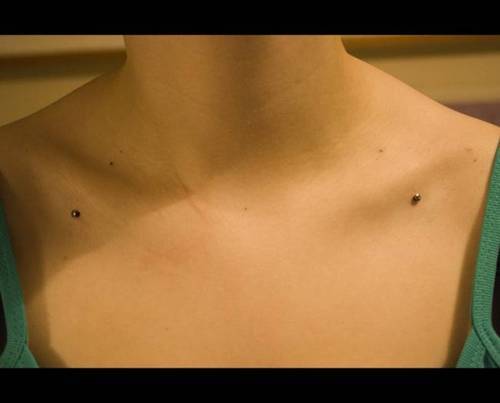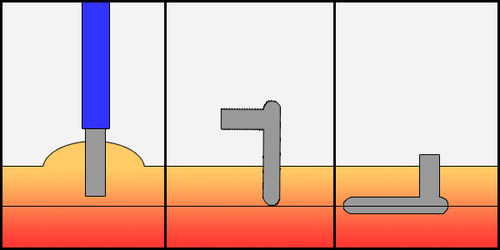- Cross contamination - Would you let a doctor reach into that red box of used, contaminated syringes, wipe it off with an antiseptic wipe and give you a shot with it? No way in hell! You have no idea who the person was before you, and even if you did you still wouldn't want to share a needle with anyone. If you said yes, then stop reading now because there is no help for you. It's the same thing with piercing guns. The section of the gun that is pressed against your ear receives a healthy dose of blood spray when the piercing is done. Because they are made with plastic they cannot be sanitized with an autoclave, all the piercers really do is wipe it down with an antiseptic wipe which does not kill blood borne pathogens such as Hepatitis or HIV. Not really the things I want to introduce a fresh opening in my body to.
- Lack of training - The main place you will run into the use of piercing guns will be at chain beauty stores and at the mall. Claire's is a popular store that offers gun piercings (often on babies too young to walk), and you can find testimonial after testimonial online of previous employees who admit to at lest been given a booklet on how to do it, and at best, two weeks of training on a stuffed animal. Someone once said that their supervisor told them to just practice on their friends till they got it down. Combining these 'professionals' with an unreliable, unsanitary piercing tool doesn't seem like the best idea.
- Tissue damage - When you pierce your ears with a needle (as it should be done) you are using a very sharp hollow needle which slices the skin smoothly and makes room for everything that will soon replace the needle. With the gun, there is no smooth piercing, it's a harsh, traumatic experience. The gun doesn't have a needle, it simply forces the rounded end of the stud through your ear, ripping the tissues apart to make way for the jewelry. Try to imagine the difference between a doctor performing surgery with a scalpel or a butter knife. Once the bar tears through your ear, your body will respond by having the injured area swell up to protect it, but unfortunately the jewelry is then capped off with the backing, pinching the already tender skin and preventing the proper swelling. My sister actually had this done years ago. Because her ear was so damaged and was not able to properly swell up, her ear actually swelled around the front of the stud and over the course of the next year it slowly pushed it all the way out the back.
- Poorly designed - Because the gun was designed for the simplest of minds to use, it doesn't have much in the area of calibration. Meaning it will work the exact same for thin ear lobes as well as really thick lobes. The problem is that not all skin is the same, so it may completely puncture one persons ear lobe, it might not be powerful enough to drive it all the way through another. This means a half pierced lobe which leaves three options: hand pushing the jewelry the rest of the way through the ear, pulling it out and re-piercing it (the chances of hitting the same hole again are very slim), or just taking it out entirely.
Till next time,
Miles...









 For sometime now I have had a fascination with
For sometime now I have had a fascination with 
 So we began carrying some amazing stone plugs, they are available in sizes 10g - 9/16". We are hoping to get larger sizes soon (at least I am). They are made very sturdy and the best part is since they are all stone, no pattern is the same so each piece is completely unique. We have them in the following stones:
So we began carrying some amazing stone plugs, they are available in sizes 10g - 9/16". We are hoping to get larger sizes soon (at least I am). They are made very sturdy and the best part is since they are all stone, no pattern is the same so each piece is completely unique. We have them in the following stones: